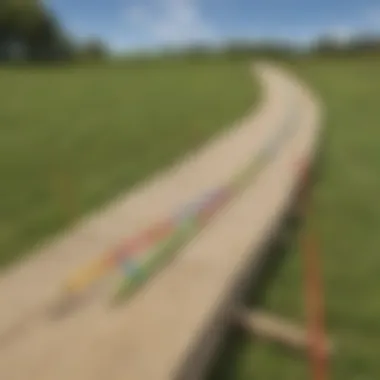Step-by-Step Guide: Building a Catapult for a Fun Science Project


Science Fun Facts
Did you know that catapults have been used for centuries in warfare and siege situations, showcasing the power of simple machines in action? The history of catapults dates back to ancient civilizations such as the Greeks and Romans, highlighting how innovations in engineering have played a crucial role throughout history.
Science Experiment Showcase
Embark on an exciting journey of discovery with LabLittles as we delve into the world of catapult construction. To start this engaging science project, gather materials such as popsicle sticks, rubber bands, a spoon, and small objects for launching. Remember to prioritize safety by wearing goggles and creating a secure workspace before beginning your catapult creation.
Interactive Learning Tools
As you explore the construction process, understand the basic principles of potential and kinetic energy at play. The catapult transforms potential energy stored in the tension of the rubber bands into kinetic energy as it launches objects into the air. Witness firsthand the conversion of energy types through this hands-on experiment, fostering a deeper comprehension of physics.
Fun and Engaging Experiments
With step-by-step instructions provided, assemble your catapult by attaching popsicle sticks to create the base and arm. Utilize rubber bands to create tension, enabling the catapult to propel objects forward. Experiment with different variables such as the angle of launch or the force applied to observe how these elements impact the distance and accuracy of your catapult.
Real-Life Applications of Science
Through this catapult-building experience, children can gain a practical understanding of engineering concepts and physics principles. By engaging in the construction process and testing the performance of their creations, young learners can develop critical thinking skills and problem-solving abilities essential for future endeavors in science and technology.
Science Quiz Time
Test your knowledge and comprehension with interactive quizzes designed to reinforce key learnings from the catapult experiment. Challenge yourself with multiple-choice questions that assess your understanding of energy transfer and mechanical advantage in catapult design. Expand your scientific vocabulary and solidify your grasp of fundamental physics concepts through engaging brain teasers and puzzles.
Safety Tips and Precautions
Prioritize safety throughout the construction and testing phases of your catapult project. Remember to wear protective gear, clear your workspace of obstructions, and follow instructions carefully to prevent accidents. Supervise children closely during the experiment to ensure a safe and enjoyable learning experience.
Learning Through Gamification
Transform learning into a fun and immersive experience by gamifying the catapult-building process. Encourage friendly competition among young enthusiasts by measuring the distance and accuracy of their catapult launches. Embrace the spirit of scientific exploration and innovation as you celebrate the achievements and learnings gleaned from this hands-on science project.
Prolusion to Catapults
In the vast realm of scientific exploration, catapults emerge as fascinating devices embodying a perfect fusion of history, physics, and engineering. Harnessing the power of tension and release, catapults have been pivotal in understanding force and motion. This article delves into the intricate world of catapults, offering young minds a gateway to practical experimentation and theoretical understanding. By unraveling the secrets of catapults, children aged 6-12 can immerse themselves in a hands-on journey of discovery and application, fostering a deep appreciation for the realms of physics and engineering.


Understanding the Concept of Catapults
History of Catapults
Diving into the historical roots of catapults unveils a tapestry woven with ingenuity and strategic warfare tactics. Historically, catapults have played a crucial role in warfare, dating back centuries to ancient civilizations. The evolution of catapults showcases humankind's relentless pursuit of innovation in military technology. Exploring this historical backdrop not only offers valuable insights into ancient engineering prowess but also serves as the cornerstone for understanding the principles of projectile motion and energy transfer in catapult mechanics. By delving into the annals of history, young enthusiasts can connect the dots between past innovations and modern engineering marvels, setting a solid foundation for their scientific quest.
Types of Catapults
Delving deeper into catapults unveils a myriad of ingenious designs that have graced the fields of battle and experimentation. From the formidable trebuchet to the versatile mangonel, each type of catapult brings forth a unique approach to propelling projectiles through the air. Understanding the distinct characteristics of various catapult types not only enriches one's knowledge in mechanical dynamics but also opens up avenues for creative exploration. By exploring the pros and cons of different catapult designs, youngsters can hone their analytical skills and nurture a deep appreciation for the utility of simple machines in achieving complex tasks. Embracing the diversity of catapults allows budding scientists to grasp the fundamental principles of mechanics and leverage this knowledge in building their catapults for engaging scientific endeavors.
Materials Needed
When embarking on the exciting journey of building a catapult, it is crucial to gather the essential materials needed for this fulfilling project. Each item plays a significant role in bringing the catapult to life and ensuring a successful outcome. Understanding the importance of these materials is integral to the overall construction process. Let's delve into the specifics of the materials required for this thrilling endeavor.
Gathering Supplies
Wood or Popsicle Sticks
Wood or popsicle sticks are the backbone of your catapult structure, providing a sturdy and reliable framework for the device. Their lightweight nature coupled with innate robustness makes them an ideal choice for this project. The versatility of wood or popsicle sticks allows for easy manipulation and customization, enabling young builders to craft their catapult according to their preferences. However, their rigidity might pose a challenge in certain assembling stages, requiring precise handling to avoid breakage.
Rubber Bands
Rubber bands are the power source of your catapult, responsible for launching projectiles with precision and force. Their elastic properties store kinetic energy when pulled back, releasing it upon launch to propel the object forward. The stretchiness of rubber bands offers adjustability in tension levels, allowing experimenters to fine-tune their catapults for optimal performance. Yet, their durability is a crucial consideration, as worn-out rubber bands may impact the accuracy and distance of your launches.
Spoon
The spoon serves as the launching mechanism for your catapult, cradling the projectile before release. Its concave shape provides a secure position for the object, ensuring a consistent launching trajectory. The curvature of the spoon aids in directing the projectile towards the desired target, enhancing precision during launch. While the spoon's design promotes efficient projectile release, its size and depth may influence the type of objects that can be launched effectively.
Small Objects for Launching
Selecting the right small objects for launching is key to testing and optimizing your catapult's performance. These objects should have ample weight to be propelled effectively by the catapult while remaining compact enough for the launching mechanism to handle. Consider experimenting with various objects to determine the best fit for your catapult, taking into account factors such as size, shape, and weight. Finding the ideal small objects for launching will help you gauge the catapult's capabilities and make necessary adjustments for an enhanced launching experience.
Building the Catapult Structure
In the realm of our catapult construction endeavor, the focal point rests on this pivotal segment - Building the Catapult Structure. Within these words, lies a wealth of significance - it serves as the very backbone upon which the catapult's functionality hinges. The structural integrity ensures the catapult's stability during launch, determining the trajectory of our miniature projectiles. Delving deeper, we uncover the intricate dance between form and function, where each component plays a crucial role in the catapult's operational prowess.
Step-by-Step Instructions


Assembling the Base
Embark on our first undertaking within the catapult construction domain - Assembling the Base. This foundational step sets the stage for the entire catapult structure, laying the groundwork for stability and accuracy. The base acts as the firm groundwork upon which our catapult's mechanisms will rest. Its stability is paramount, dictating the success of our launching endeavors. The simplicity of this step belies its importance; a sturdy base ensures a steady platform for our further construction endeavors, facilitating a smooth catapult assembly process.
Attaching the Arm
Moving swiftly to our next endeavor, we encounter the task of Attaching the Arm. This pivotal step defines the catapult's reach and power, determining the distance our projectile will travel. The attachment of the arm shapes the catapult's trajectory, making it a critical element in our construction process. The selection of materials for the arm holds immense significance, influencing the catapult's overall performance. Careful consideration and precision during this step will reap rewards in the catapult's efficiency and accuracy.
Securing the Rubber Bands
As we progress through the construction of our catapult, the segment of Securing the Rubber Bands emerges as a key player in the intricate web of catapult mechanics. The rubber bands are the unsung heroes, providing the tension necessary for launching our projectiles. Their secure attachment ensures a reliable launching mechanism, enhancing the catapult's overall efficacy. Attention to detail in securing these rubber bands is paramount, for even a minor slip-up could impede the catapult's performance. The balancing act synonymous with this step underscores the delicate nature of catapult construction, highlighting the importance of precision and meticulous execution.
Testing and Adjusting
Testing and adjusting the catapult is a crucial phase in ensuring optimal performance and accuracy. By systematically evaluating different variables and making necessary adjustments, young scientists can fine-tune their catapults for maximum efficiency. This process not only hones their critical thinking skills but also deepens their understanding of the principles of force and motion. Through launching practice sessions, children can observe how changes in tension and aiming angles impact the trajectory of their projectiles. This hands-on experimentation fosters a sense of curiosity and discovery, laying a strong foundation for future explorations in physics and engineering.
Launching Practice
Launching practice is where young engineers put their theoretical knowledge into action. One key aspect of launching practice is adjusting tension. By modifying the tension in the rubber bands, children can control the amount of force applied to the projectile. This adjustment can significantly affect the distance and speed at which the projectile is launched. Understanding how tension impacts the catapult's performance is essential for achieving desired results during testing. Experimenting with different levels of tension allows children to grasp the relationship between force and motion, enriching their scientific inquiry.
Another critical aspect of launching practice is mastering aiming techniques. Aiming is a skill that requires precision and focus. By refining their aiming techniques, young builders can enhance the accuracy of their launches, hitting targets with pinpoint accuracy. Factors such as launch angle and projectile weight influence the projectile's trajectory, making it imperative for children to practice and perfect their aim. Through trial and error, they can develop strategies to improve their aim, learning the valuable lesson of persistence and iterative refinement in problem-solving. Mastering aiming techniques not only enhances the fun and challenge of catapult building but also equips children with practical skills applicable in various STEM disciplines.
Exploring Catapult Mechanics
In this segment, we will delve into the intricate mechanics behind catapults, shedding light on how these fascinating devices function. Understanding catapult mechanics is crucial for aspiring young engineers as it provides a foundation in physics and engineering principles. By exploring catapult mechanics, children can grasp concepts like force, motion, and energy transfer in a hands-on and interactive manner.
One key element to consider when exploring catapult mechanics is the impact of arm length. The arm length of a catapult directly influences its throwing distance and projectile speed. Longer arms can store more potential energy, resulting in a more powerful launch. This aspect is pivotal in catapult design, as it determines the efficiency and effectiveness of the device. Understanding the impact of arm length equips young learners with the knowledge to optimize their catapults for better performance.
Another essential aspect of catapult mechanics is the influence of launch angle. The launch angle plays a significant role in determining the trajectory of the launched object. By adjusting the launch angle, children can experiment with different flight paths and distances. Understanding how launch angle affects the projectile's motion enables young enthusiasts to fine-tune their catapults for specific targets. This exploration fosters problem-solving skills and cultivates a deeper understanding of projectile motion.
Understanding Force and Motion
Impact of Arm Length
Delving into the impact of arm length on a catapult's performance reveals crucial insights into the device's functionality. The arm length directly affects the mechanical advantage of the catapult system, influencing the force applied to the launching mechanism. Longer arms can store more potential energy, allowing for a more forceful projection of the projectile. This characteristic is instrumental in achieving greater distances and velocities when launching objects. The significance of arm length lies in its direct correlation to the catapult's power and efficiency.
Influence of Launch Angle


The influence of launch angle on catapult operation is a key consideration in optimizing throwing accuracy and distance. The launch angle dictates the trajectory of the projectile and influences its flight path. By varying the launch angle, users can control the height and range of the launched object. This control over launch angle empowers young learners to experiment with different settings to achieve desired outcomes. Understanding the influence of launch angle equips enthusiasts with the knowledge to adjust and customize their catapults for diverse scenarios, enhancing their overall learning experience.
Enhancing the Catapult Design
In the realm of catapult construction, the facet that elevates a project from mere mechanics to a masterpiece is the pivotal stage of enhancing the catapult design. This section delves into the critical importance of refining and customizing the catapult beyond its basic functionality, paving the way for creative expression and optimized performance. By integrating various elements that go beyond the standard blueprint, enthusiasts can unlock potential enhancements that push the boundaries of traditional catapult design.
Embarking on the journey of enhancing the catapult design opens a realm of possibilities for young engineers and innovators. The addition of personalized touches and modifications not only enhances the visual appeal of the catapult but also allows for a deeper connection with the project. Through customization, individuals can infuse their personality and style into the catapult, transforming it from a simple science experiment into a personalized creation that showcases individuality and creativity.
When considering enhancing the catapult design, several key benefits come to the forefront. Customization enables children to develop their artistic skills by brainstorming and implementing unique decorative elements. Moreover, customizing the catapult fosters a sense of ownership and pride in the project, instilling a deeper level of commitment and engagement in the learning process. By encouraging personalization, children are motivated to fully invest themselves in the project, leading to a more profound understanding of the underlying scientific principles.
In the realm of catapult customization, one must carefully consider several essential aspects to ensure a seamless integration of design enhancements. Factors such as weight distribution, material durability, and aesthetic appeal play a crucial role in determining the success of the customization process. By balancing practicality with creativity, young builders can achieve a harmonious blend of functionality and aesthetics in their enhanced catapult design.
Customization Tips
Decorative Additions
When exploring the realm of decorative additions for catapult design enhancement, one must appreciate the transformative power of visual embellishments. Decorative additions offer a unique opportunity to infuse personality and flair into the project, elevating it from a simple apparatus to a visually striking creation. The incorporation of colorful embellishments, such as paint, stickers, or creative motifs, can breathe life into the catapult, making it a captivating centerpiece of any scientific exploration.
The key characteristic of decorative additions lies in their ability to stimulate imagination and creativity. By allowing children to experiment with various design elements, decorative additions serve as a catalyst for artistic expression and innovation. Furthermore, the engaging nature of visual enhancements helps maintain interest and enthusiasm throughout the catapult building process, ensuring a dynamic and fulfilling experience for young builders.
A standout feature of decorative additions is their versatility in enhancing the overall appeal of the catapult while providing a platform for self-expression. However, it is essential to strike a balance between aesthetic enhancements and practical considerations to ensure that the catapult remains fully functional. While decorative additions can undoubtedly enhance the visual allure of the catapult, careful consideration must be given to maintain structural integrity and optimal performance.
Testing Different Materials
The exploration of various materials for catapult construction stands as a cornerstone of design customization, offering insight into the impact of material choice on catapult performance and durability. Testing different materials not only broadens young builders' understanding of material science but also presents an opportunity to experiment and optimize the catapult design for superior functionality.
An essential aspect of testing different materials is the focus on material properties such as flexibility, density, and weight. By experimenting with diverse materials like different types of wood, plastics, or metals, children can observe firsthand how material characteristics influence the catapult's launching mechanism and overall efficiency. This hands-on experimentation fosters critical thinking skills and scientific inquiry, laying a strong foundation for future engineering pursuits.
The significance of testing different materials transcends mere trial and error, offering valuable insights into the engineering principles behind catapult construction. By comparing and contrasting the performance of varied materials, young builders can make informed decisions regarding material selection, leading to a more refined and optimized catapult design. Through the process of material testing, children develop a nuanced understanding of material science and its practical applications, equipping them with essential knowledge for future STEM endeavors.
Finale
The Conclusion section marks the culminating point of this comprehensive guide on building a catapult for kids aged 6-12. Throughout this engaging journey, young enthusiasts have delved into the realms of physics and engineering, fostering a hands-on learning experience that transcends traditional educational boundaries. By constructing their catapult, children not only grasp the practical application of theoretical concepts but also develop essential skills in problem-solving and creativity. This hands-on project serves as a bridge between theoretical knowledge and practical application, offering a sneak peek into the fascinating world of science and technology.
Educational Value of the Project
Hands-On Learning Experience
The Hands-On Learning Experience component of this project plays a pivotal role in enhancing children's understanding of scientific principles. Through tactile engagement in the construction process, kids gain a profound insight into the laws of physics and mechanics. The hands-on approach fosters a deeper connection with the subject matter, allowing for a more memorable and impactful learning experience. Furthermore, the interactive nature of this project ignites curiosity and promotes critical thinking skills, empowering children to explore, experiment, and discover the wonders of science in a tangible way.
Application of Physics Concepts
The Application of Physics Concepts in this catapult-building project not only imparts theoretical knowledge but also cultivates a practical understanding of the subject. By observing the effects of arm length and launch angle on the catapult's performance, children witness physics principles in action. This real-world application of abstract concepts bridges the gap between theory and practice, making physics more engaging and relatable. Moreover, applying physics concepts in a hands-on project like building a catapult nurtures a holistic understanding of the subject, setting a strong foundation for future scientific exploration.







